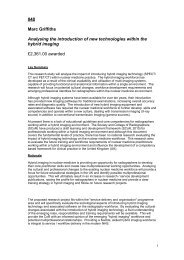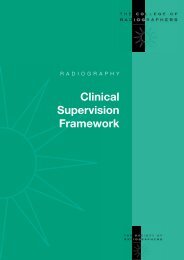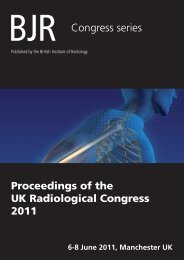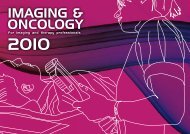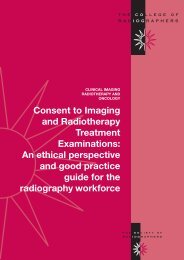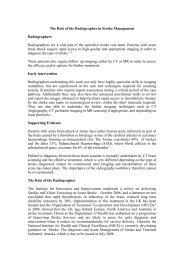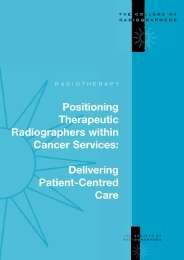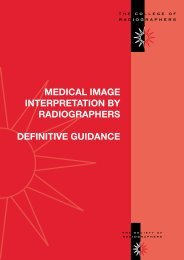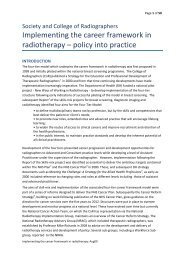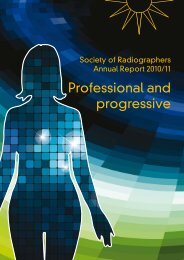Imaging & Oncology - Society of Radiographers
Imaging & Oncology - Society of Radiographers
Imaging & Oncology - Society of Radiographers
You also want an ePaper? Increase the reach of your titles
YUMPU automatically turns print PDFs into web optimized ePapers that Google loves.
Radiology in a developed country is challenging enough with its ever changing<br />
technologies. Can it be implemented successfully in a developing country such as Haiti?<br />
In 1997, Project Haiti <strong>of</strong> Saint Alphonsus Regional Medical Center in<br />
Boise, Idaho, US was asked to assess the need for and possibility <strong>of</strong><br />
establishing radiology at Saint Damien’s Paediatric Hospital in Port au<br />
Prince, Haiti. Formed in 1995, Project Haiti supports the medical needs <strong>of</strong><br />
Saint Damien’s Hospital. A refurbished mobile x-ray machine had already<br />
been donated and shipped to Saint Damien’s.<br />
consistent, high quality technology, running water, electricity, and access<br />
to supplies and imaging equipment. At Saint Damien’s the basic needs<br />
for radiology were elusive. Electricity was unreliable. Running water was<br />
scarce and unsafe. Water was delivered to the well twice a day and stored<br />
in buckets. The donated mobile was not working and beyond my skills to<br />
repair. The darkroom was a closet consisting <strong>of</strong> four bare walls.<br />
Was it functional? Was radiology needed, and if so, was it<br />
possible?<br />
As a radiographer I was asked to go to Haiti to assess the radiology<br />
situation. It was an exciting and challenging opportunity and one for which I<br />
thought I was emotionally and pr<strong>of</strong>essionally prepared.<br />
Facts<br />
Haiti is a developing country in North America’s Caribbean with an<br />
estimated population <strong>of</strong> 10 million 1 . Extreme poverty is widespread<br />
throughout the tiny country. Around 80% <strong>of</strong> the population is below the<br />
poverty line and only 50% is literate. The average life expectancy is 60<br />
years for a man and 63 years for a woman. Infant mortality staggers at 52<br />
deaths out <strong>of</strong> 1000 live births and half the deaths in one day are children<br />
under the age <strong>of</strong> five. Tuberculosis, malnutrition and HIV are prevalent 1,2 .<br />
Housing predominantly consists <strong>of</strong> dilapidated shacks without running<br />
water, sewerage, or electricity. Very soon after arriving in Haiti I realised that<br />
nothing can prepare one for this extreme poverty.<br />
Background to Saint Damien’s Hospital, Haiti<br />
In 1987, Father Rick Frechette, an American born Catholic priest, designed<br />
Saint Damien’s hospice for the sick and dying children <strong>of</strong> his orphanage to<br />
separate the dying children from those who had a chance <strong>of</strong> survival. Since<br />
then, Saint Damien’s hospice has evolved into a fully-fledged paediatric<br />
hospital (figure 1). Frustrated by the shortage <strong>of</strong> physicians in Haiti, Father<br />
Frechette applied for and was accepted to medical school in the United States.<br />
After obtaining his medical doctor degree in 1999, Fr/Dr Frechette returned to<br />
Haiti permanently to practice medicine and to minister as a priest.<br />
From Idaho to Haiti<br />
The reality <strong>of</strong> Haiti was stark. My comfortable life was far removed as I saw<br />
first hand poverty that was incomprehensible. As a radiographer at Saint<br />
Alphonsus Regional Medical Centre in Boise, Idaho, I can rely on having<br />
With modern technology unsupported, critical thinking skills momentarily<br />
escaped me in the immensity <strong>of</strong> the challenge ahead. I questioned how<br />
anything could be possible here, especially in radiology where a solid<br />
infrastructure is needed and yet did not exist. My initial assessment was<br />
bleak: radiology would not be possible at Saint Damien’s. Nevertheless,<br />
the following day I travelled with a group <strong>of</strong> Saint Damien’s patients to a<br />
clinic for radiographs. Some babies and children were accompanied by<br />
parents so our medical transport in the back <strong>of</strong> a truck for 90 minutes in<br />
the hot sun was stifling. Since Haiti has no solid medical structure as a<br />
pay-for-service country, the clinic we were going to did not triage patients<br />
by medical needs. They were triaged by economical means and paying<br />
customers were x-rayed ahead <strong>of</strong> those without funds. Saint Damien’s runs<br />
strictly on donations so the sick patients <strong>of</strong> Saint Damien’s were x-rayed last.<br />
After four hours <strong>of</strong> waiting, our patients were finally addressed. One baby<br />
was so sick I questioned if she would survive. She was cyanotic, and her<br />
breathing shallow and congested. Her mother would pinch her, forcing her<br />
to take a gasp <strong>of</strong> air. Radiographs confirmed her severe condition — double<br />
pneumonia with cardiomegaly and tracheal shift. In a developed country she<br />
would be in an intensive care unit. In Haiti she rode in a truck bed for an all<br />
day excursion for a radiograph. In that moment my mindset changed to “we<br />
will do everything possible to have radiology available at Saint Damien’s.”<br />
“Paying customers<br />
were x-rayed ahead <strong>of</strong><br />
those without funds”<br />
IMAGING & ONCOLOGY 2013 { 63 }






